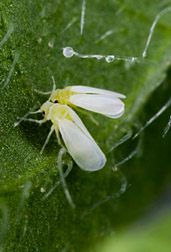This page has been archived and is being provided for reference purposes only. The page is no longer being updated, and therefore, links on the page may be invalid.
|
|
|
|
New Online Help for Managing Whiteflies
By Alfredo Flores
August 22, 2007
Tiny, sap-sucking whiteflies—and the diseases they often spread—cause some of the world's worst crop problems and are responsible for enormous losses every year. Now an online resource has been developed to help growers afflicted by the pests.
Agricultural Research Service (ARS) scientists in the agency's Subtropical Insects Research Unit (SIRU), including entomologist Cindy McKenzie—in collaboration with the University of Florida, the University of California, the University of Georgia, Texas A & M University and Cornell University, and endorsed by industry groups such as the Society of American Florists, American Nursery & Landscape Association and the IR-4 Project—have developed a website with extensive information about whitefly management. SIRU is part of ARS' U.S. Horticultural Research Laboratory in Fort Pierce, Fla.
Whiteflies are found throughout the tropics and subtropics, but can be troublesome in greenhouses and other growing environments as well. Both immature and adult stages ingest plant sap and cause damage directly, by feeding and transmitting plant viruses, or indirectly, by excreting a sticky substance called honeydew onto leaves and fruit. Sooty mold fungi colonize the contaminated surfaces, further interfering with photosynthesis and ultimately resulting in reduced quality of fruit and fiber. In addition to ornamentals, whiteflies attack cassava, cotton, sweet potato, legumes and many other vegetables grown in mixed or annual cropping systems.
Called "Management Program for Whiteflies on Propagated Ornamentals With an Emphasis on the Q-biotype."
Among the many topics covered at the website are the importance of crop hygiene, pre- and post-planting practices and insecticide recommendations. Also stressed is the need to control whiteflies early, before they spread to neighboring fields.
Proper use of insecticides is important for whitefly management, particularly with respect to avoiding development of insecticide resistance in whiteflies. The online guide recommends that insecticides be rotated between chemical classes and should be applied a minimum of two times, at a five- to seven-day interval, to allow for egg hatch between applications and ensure that adults, nymphs and newly hatched individuals are all killed.
ARS is the U.S. Department of Agriculture's chief scientific research agency.

